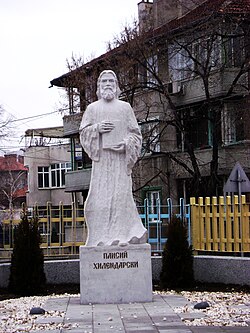Paisius of Hilendar
Paisiy of Hilendar Свети Паисий Хилендарски Sveti Paisiy Hilendarski | |
|---|---|
 | |
| Venerable | |
| Born | 1722 Bansko (?), Samokov eparchy (diocese), Ottoman Empire (now Bulgaria) |
| Died | c. 1773 Stanimaka (now Asenovgrad), Ottoman Empire (now Bulgaria) |
| Venerated in | Eastern Orthodox Church[1] |
| Canonized | 26 June 1962 by the Bulgarian Orthodox Church |
| Feast | 19 June |
| Patronage | Bulgaria |
Saint Paisius of Hilendar or Paìsiy Hilendàrski (Bulgarian: Свети Паисий Хилендарски) (1722–1773) was a Bulgarian Orthodox clergyman and a key Bulgarian National Revival figure. He is most famous for being the author of Istoriya Slavyanobolgarskaya (1762), the first significant modern Bulgarian history that became famous and has been copied and distributed everywhere in the Bulgarian lands. The book is, overall, the third modern work of Bulgarian history, after the works titled "History of Bulgaria" by Petar Bogdan Bakshev in 1667[2] and by Blasius Kleiner in 1761. He is considered the forefather of the Bulgarian National Revival.[3]
Paisius was born in the Samokov eparchy of the time. There is a scientific dispute about the exact place of his birth, although the prevailing consensus points to the town of Bansko.[4][5][6] He established himself in the Hilandar monastery in 1745, where he was later a hieromonk and deputy-abbot. Collecting materials for two years through hard work and even visiting the Habsburg monarchy, he finished his Istoriya Slavyanobolgarskaya in 1762 in the Zograf Monastery.[7] The book was the first attempt to write a complete history of Bulgaria and attempted to awaken and strengthen Bulgarian national consciousnesses.[8]
The most famous part of the whole book is the paragraph:
"Oh, you unwise moron! Why are you ashamed to call yourself a Bulgarian and why don't you read and speak in your native language? Weren't Bulgarians powerful and glorious once? Didn't they take taxes from strong Romans and wise Greeks? Out of all the Slavic nations they were the bravest one. Our rulers were the first ones to call themselves emperors, the first ones to have patriarchs, the first ones to baptise their people.(...) Why are you ashamed of your great history and your great language and why do you leave it to turn yourselves into Greeks? Why do you think they are any better than you? Well, here you're right because did you see a Greek leave his country and ancestry like you do?"
This more or less signifies the purpose of the author who speaks about the danger of Bulgarians falling victim to the Hellenization policies of the mainly Greek clergy. [9][10][11] The book's first manual copy was done by Sophronius of Vratsa in 1765. Structurally, Istoriya Slavyanobolgarskaya consists of two introductions, several chapters that discuss various historic events, a chapter about the "Slavic teachers", the disciples of Cyril and Methodius, a chapter about the Bulgarian saints, and an epilogue. As Paisius toured Bulgaria as a mendicant friar, he brought his work, which was copied and spread among the Bulgarians. He is thought to have died on the way to Mount Athos near Ampelino (modern-day Asenovgrad).

Veneration and Legacy
On 26 June 1962, he was canonised by the Bulgarian Orthodox Church with the title of "Venerable".[12]
He is venerated in the Eastern Orthodox Church as a saint, particularly in the Bulgarian Orthodox Church, sharing a feast day with his namesake, St. Paisius the Great, on 19 June.[12]
Paisiy Peak on Livingston Island in the South Shetland Islands, Antarctica is named after Paisiy of Hilendar.[13]
The saint is portrayed on the obverse of the Bulgarian 2 lev banknote, issued in 1999 and 2005.[14]
References and notes
- ^ Всяка година на 19 юни честваме паметта на Св. Паисий Хилендарски.
- ^ Bourchier, James David (1911). . In Chisholm, Hugh (ed.). Encyclopædia Britannica. Vol. 04 (11th ed.). Cambridge University Press. pp. 779–784, see page 781.
The National Revival...
- ^ Daskalov, Rumen (2004). The Making of a Nation in the Balkans: Historiography of the Bulgarian Revival. Central European University Press. pp. 7–8. ISBN 963-9241-83-0.
- ^ MacDermott, Mercia (1962). A History of Bulgaria 1395–1885. New York: Frederick A. Praeger. p. 91. Retrieved 21 June 2021 – via Internet Archive.
- ^ "История на България", Издателство на Българската академия на науките, т. 5, София 1985, с. 128.
- ^ The Encyclopedia of Eastern Orthodox Christianity, John Anthony McGuckin, John Wiley & Sons, 2011, ISBN 1405185392, p.85.
- ^ Buchan, John, ed. (1924). "Bulgaria". Bulgaria and Romania: The Nations of Today; A New History of the World. Boston and New York: Houghton Mifflin Company. p. 30. Retrieved 21 June 2021 – via Internet Archive.
- ^ Berend, Tibor Iván (2003). History Derailed: Central and Eastern Europe in the Long Nineteenth Century. University of California Press. p. 76. ISBN 0-520-23299-2.
- ^ The Formation of a Nationalist Bulgarian Intelligentsia, 1835-1878, Modern European history: a Garland series of outstanding dissertations, Thomas A. Meininger, Garland Pub., 1987, ISBN 0824080289, p. 75.
- ^ The Making of a Nation in the Balkans: Historiography of the Bulgarian Revival, Rumen Daskalov, Central European University Press, 2004, ISBN 9639241830, pp. 152-155.
- ^ Eastern Europe: an introduction to the people, lands, and culture. Vol. 2, Richard C. Frucht, ABC-CLIO, 2004, ISBN 1576078000, pp. 821-822.
- ^ a b "Venerable Paisius of Hilandar, Bulgaria". www.oca.org. Retrieved 2024-08-15.
- ^ Paisiy Peak SCAR Composite Gazetteer of Antarctica
- ^ Bulgarian National Bank. Notes and Coins in Circulation: 2 levs (1999 issue) & 2 levs (2005 issue). – Retrieved on 26 March 2009.
